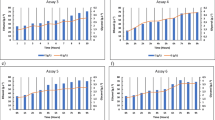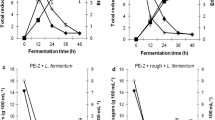Abstract
The goal of this work is to optimize production of bio-ethanol by fermentation through regulating yeast growth energy (YGE), and provide the mechanism of ethanol production from food-waste leachate (FWL) using yeast (S. cerevisiae) as inoculums to be predictable and controllable. The wide range of reduced sugar concentration (RSC) which is commonly administered from low (35 g per liter) to very high (100 g per liter) is responsible for costs increasing besides risks of FWL contamination and death of yeast cells. A mathematical model is presented to describe yeast growth energy (YGE) due to RSC doses along with predicting the amounts of ethanol yield by each dose to identify the optimum one. Simulations of the presented model showed that YGE, energy intake (EI), and their produced ethanol energy (PEE) are always balanced during fermentation process according to the law of conservation of energy. For a better fermentation rate in a continuous process and a large-scale production; YGE should be less than half of EI and more than its quarter (i.e. \( \frac{ 1}{ 4}{\text{EI}} \le {\text{YGE}} \le \frac{1}{2}{\text{EI}} \)) which keeps the residual energy less than YGE to avoid risks of osmotic stresses or aging of cells allowing the survival of all yeast cells as long as possible to maximize ethanol production and decrease productivity costs.


Similar content being viewed by others
Abbreviations
- EI:
-
Energy intake
- RE:
-
Residual energy
- CE:
-
Consumed energy
- PPE:
-
Produced ethanol energy
- tD :
-
Doubling time
- CGE:
-
Cell growth energy
- YGE:
-
Yeast growth energy
References
APHA (1998) Standard methods for examination of water and wastewater. American Public Health Association, Washington D.C
Austriaco NRJ (1996) Review: to bud until death: the genetics of ageing in the yeast Saccharomyces. Yeast 12:623–630
Bai F, Anderson W, Young M (2007) Ethanol fermentation technologies from sugar and starch feedstocks. Biotechnol Adv 26:89–105
Diaz-Ricci J, Tsu M, Bailey J (1992) Biotechnol Bioeng 39:59
Douka E, Koukkou A, Vartholomatos G, Frillingos S, Papamichael E, Drianas C (1999) A Zymomonas mobilis mutant with delayed growth on high glucose concentrations. J Bacteriol 181(15):4598–4604
Garda J, Macedo RM, Faria R, Bernd L, Dors GC, Furlong EB (2005) Alcoholic fermentation effects on malt spiked with trichothecenes. Food Control 16:423–428
Hill P, Klaptach T, Lynd L (1993) Biotechnol Bioeng 42:873–883
Kadambiniguar (2006) PROCESS optimization for the production of ethanol via fermentation, Patiala-147004
Kennedy B, Austriaco NRJ, Guarente L (1994) Daughter cells of Saccharomyces cerevisiae from old mothers display a reduced life span. J Cell Biol 127:1985–1993
Lang K, Lang P, Bauer C (2005) Mechanisms of suicidal erythrocyte death. Cell Physiol Biochem 15(5):195–202
Le Man H, Kim JW, Park HS (2008) Optimization of ethanol production from Korean food waste leachate using response surface methodology. In Korea Society of Waste Management conference, Sunchon University, Sunchon,Republic of Korea 8–10 May
Le Man H, Behera S, Park H (2010) Optimization of operational parameters for ethanol production from Korean food waste leachate. Int J Environ Sci Tech 7(1):157–164
Man H, Rene E, Behera S, Park H (2011) Main and interaction effects of process parameters on the ethanol production capacity of food: waste leachate by saccharomyces cerevisiae. KSCE J Civil Eng 15(6):1015–1022
Miller GL (1959) Use of DNS reagent for determination of reducing sugars. Anal Chem 31:426–428
Moawad E (2010) Isolated system towards a successful radiotherapy treatment. Nucl Med Mol Imaging 44:123–136
Moawad E (2011a) Radiotherapy and risks of tumor regrowth or inducing second cancer. Cancer Nano 2:81–93
Moawad E (2011) Bioethanol production by fermentation is an energy balance process, 19th European Biomass Conference and Exhibition, DOI: 10.5071/19thEUBCE2011VP4.5.1. http://www.etaflorence.it/proceedings/index.asp?detail=6521&searchstring=Bioethanol
Moawad EY (2012a) Clinical and pathological cancer staging at the nanoscale, Cancer Nanotechnol. doi:10.1007/s12645-012-0028-x
Moawad EY (2012b) Reconciliation between the clinical and pathological staging of cancer, Comp Clin Pathol. doi:10.1007/s00580-012-1603-6
Nahvi I, Emtiaxi G, Alkabi L (2002) Isolation of a flocculating Saccharomyces cerevisiae and investigation of its performance in the fermentation of beet molasses to ethanol. Biomass Bioenerg 23:481–486
Pena A, Cinco G, Gomez-Puyou A, Tuena M (1972) Effect of the pH of the incubation medium on glycolysis and respiration in Saccharomyces cerevisiae. Arch Biochem Biophys 153(2):413–425
Phisalaphong M, Srirattana N, Tanthapanichakoon W (2005) Mathematical modeling to investigate temperature effect on kinetic parameters of ethanol fermentation”. Biochem Eng J 28:36–43
Sprenger G (1996) Carbohydrate metabolism in Zymomonas mobilis: a catabolic highway with some scenic routes. FEMS Microbiol Lett 145:301–307
Tang Y, Koike Y, Liu K, An M, Morimura S, Wu X, Kida K (2008) Ethanol production from kitchen waste using the flocculating yeast Saccharomyces cerevisiae strain KF-7. Biomass Bioenerg 32:1037–1045
Voet D, Voet J (1995) Biochemistry (2nd ed.). New York, NY: John Wiley & Sons. ISBN978-0471586517
Xin L, Yongfei L, Zuoying D, Zhouygui M (2003) The effect of effect of different substrate concentration on ethanol fermentation. Fd Ferment Indus 29:21–23
Yadav B, Sheoran A, Rani U, Singh D (1997) High ethanol productivity in an immobilized cell reactor Indian. J Microbiol 37:65–67
Conflict of interest
The author declares that there is no conflict of interest concerning this paper.
Author information
Authors and Affiliations
Corresponding author
Additional information
The author is a member of the Korean Society of Nuclear Medicine and of the World Conference of Interventional Oncology (WCIO) USA.
Rights and permissions
About this article
Cite this article
Moawad, E.Y. Optimizing bioethanol production by regulating yeast growth energy. Syst Synth Biol 6, 61–68 (2012). https://doi.org/10.1007/s11693-012-9099-6
Received:
Revised:
Accepted:
Published:
Issue Date:
DOI: https://doi.org/10.1007/s11693-012-9099-6




